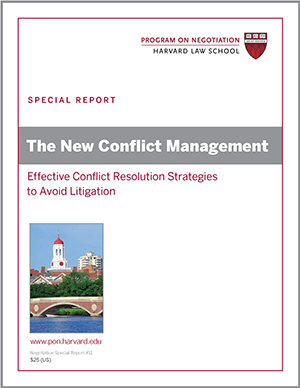
Adapted from “Just What the Doctor Ordered?,” first published in the September 2011 issue of the Negotiation newsletter.
Medical-malpractice litigation can be a lengthy, expensive, and contentious process. Lawyers on both sides might spend months or years conducting discovery and deposing witnesses. As for settlement negotiations, they tend to occur late in the process and are often treated as a perfunctory step before a trial.
In New York State, hospitals spend more than $1 billion annually on medical-malpractice expenses, and malpractice insurance rates for New York health-care providers are among the highest in the nation. Last year, the New York State Department of Health unveiled a three-year pilot program aimed at improving patient safety and reducing malpractice costs. A key component of the program: judge directed negotiation, a process that involves judges in mediating early settlements of cases that would otherwise go to trial.
A grassroots process
The concept of judge-directed negotiation was developed by Judge Douglas McKeon of Bronx
County Supreme Court to tackle a backlog of medical-malpractice cases. McKeon meets in his chambers with attorneys representing both sides of a dispute, typically a patient or a deceased patient’s family and a hospital being sued for injury or death.
Drawing on his years of experience presiding over malpractice trials, McKeon advises each side on what they can reasonably expect from a jury and then tries to steer the parties toward agreement. His goal: to convince both sides to reduce their aspirations in exchange for a speedy conclusion, lower legal bills, and the security of a known outcome.
The judge, who audited anatomy classes to improve his medical knowledge, is assisted by a nurse with legal training.
As McKeon’s model expanded into a formal program, 70 New York judges took a crash course on medical topics and also received mediation and negotiation training. The program boasts a 95% settlement rate and is estimated to have saved about $66 million in annual malpractice costs. The federal Agency for Healthcare Research and Quality, which funds the program, estimates that it could save more than $1 billion annually on a national level.
Cure-all or quick fix?
Is judge-directed negotiation ready to expand nationally? The jury is still out.
On the plus side, by convening parties early at the negotiating table, the process can head off adversarial posturing and entrenched positions. After a doctor apologizes for a serious error, a patient might lower his financial demands. And when a patient describes the daily challenges imposed by an injury, a hospital may no longer dismiss her claim as frivolous—especially when a judge takes her side.
As experienced negotiators well know, the desire to be heard and understood can be at least as important to parties as their financial concerns. In addition, an experienced judge’s evaluation of the relative merit of their cases may temper parties’ unrealistic expectations about winning big in court. Yet as judge-directed negotiation expands, some observers fear that clients will be shut out of courtrooms, freeing lawyers to haggle in private over the price of a misdiagnosis or botched surgery.
And although parties are technically free to reject a settlement and go to court, a judge’s cajoling may intimidate them into accepting an offer that they view as unfair.
The process also invites criticism by borrowing some elements of mediation and neglecting others. Neutrality, for example, is a central requirement of mediation, yet judges who have experience presiding over medical-malpractice trials might bring a degree of bias toward one side or the other. Judges in the new program are also free to express their opinions about parties’ offers—typically a mediation no-no.
Despite its flaws, judge-directed negotiation appears to be a promising method of addressing the inefficiencies of medical-malpractice claims and could serve as a model for other types of tort cases as well.
Related Article: Dealmaking – 5 Tips for Closing the Deal





